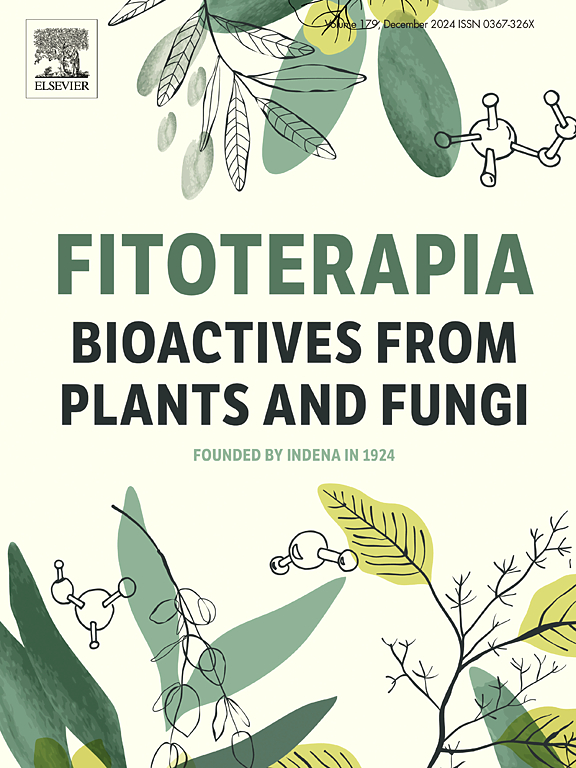芦荟花提取物通过激活PI3K/Akt信号通路抑制黑色素生成:网络药理学和实验验证
IF 2.5
3区 医学
Q3 CHEMISTRY, MEDICINAL
引用次数: 0
摘要
芦荟是一种传统草药,已有数千年的使用历史。然而,人们通常认为芦荟花无用,并将其丢弃。虽然最近有一些研究发现芦荟花提取物(AVFE)在体外具有抑制酪氨酸酶(TYR)活性的能力,但目前还缺乏芦荟花提取物作为美白剂在体外和体内抗黑色素生成的系统研究。因此,本研究对 AVFE 在体外 B16F10 细胞模型和体内斑马鱼胚胎模型中的抗酪氨酸酶活性和抗黑色素生成作用、AVFE 的全成分分析、网络药理学和黑色素生成相关信号通路的蛋白表达进行了深入研究。结果表明,AVFE可通过激活PI3K/Akt信号通路中p-Akt和p-GSK-3β的磷酸化,进而降低MITF的磷酸化,下调TYR、TRP1和TRP2的表达水平,最终减少TYR、TRP1、TRP2和黑色素的合成,从而显著降低细胞TYR活性和黑色素含量。此外,AVFE 的 24 种成分很可能是造成其皮肤脱色的原因。总之,这项研究为了解 AVFE 对皮肤色素沉着的作用机制提供了依据,也为 AVFE 作为皮肤美白剂应用于化妆品中提供了可能。本文章由计算机程序翻译,如有差异,请以英文原文为准。

Aloe Vera flowers extracts inhibit melanogenesis via activating PI3K/Akt signaling pathway: Network pharmacology and experimental validation
Aloe vera is a traditional herbal medicine that has been used for thousands of years. However, its flowers are commonly considered useless and discarded. Although, a few recent studies find Aloe vera flowers extracts (AVFE) with ability to inhibit tyrosinase (TYR) activity in vitro, systematic research on AVFE as skin whitening agent against melanogenesis in vitro and in vivo is yet lack. Therefore, the anti-TYR activity and anti-melanogenic effects of AVFEs in vitro B16F10 cell model and in vivo zebrafish embryo model, analysis of all-components of AVFE, network pharmacology and protein expression of melanogenesis-related signaling pathways were well conducted in this study. The results demonstrated that AVFE could significantly reduce cellular TYR activity and melanin content via activating the phosphorylation of p-Akt and p-GSK-3β in PI3K/Akt signaling pathway, followed by reducing the phosphorylation of MITF and then downregulation of TYR, TRP1 and TRP2 expression levels, and finally decreasing TYR, TRP1, TRP2 and melanin syntheses. In addition, 24 components of AVFE were most likely responsible for its skin depigmentation. In conclusion, this study provides a basis for understanding the mechanism of AVFE on skin depigmentation, as well as a potential for applying AVFE as skin whitening agent in cosmetics.
求助全文
通过发布文献求助,成功后即可免费获取论文全文。
去求助
来源期刊

Fitoterapia
医学-药学
CiteScore
5.80
自引率
2.90%
发文量
198
审稿时长
1.5 months
期刊介绍:
Fitoterapia is a Journal dedicated to medicinal plants and to bioactive natural products of plant origin. It publishes original contributions in seven major areas:
1. Characterization of active ingredients of medicinal plants
2. Development of standardization method for bioactive plant extracts and natural products
3. Identification of bioactivity in plant extracts
4. Identification of targets and mechanism of activity of plant extracts
5. Production and genomic characterization of medicinal plants biomass
6. Chemistry and biochemistry of bioactive natural products of plant origin
7. Critical reviews of the historical, clinical and legal status of medicinal plants, and accounts on topical issues.
 求助内容:
求助内容: 应助结果提醒方式:
应助结果提醒方式:


